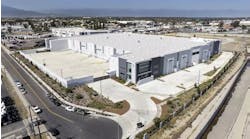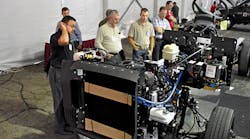Isuzu’s all-new entry in the Class 6 medium-duty truck segment—the 2018 Isuzu FTR—is almost here.
Isuzu began production on the truck on May 8 at a new 80,000-square-foot Spartan Motors facility in Charlotte, Michigan, which represents a $6.5 million investment. Much of the engineering for the truck was done at the Isuzu Technical Center of America in Plymouth, Michigan, and many of the parts for it are US-sourced.
“This is still pretty new, so we’re going to continue to see this grow,” said Tim Ellsworth, product planning manager. “It has a wide variety of applications. The big picture we want to share is that this is going to be a great Class 6 truck that will accommodate a lot of the needs of different types of applications and equipment.”
The FTR is powered by Isuzu’s 4HK1-TC 5.2-liter turbocharged four-cylinder diesel engine—a first in the segment. It generates 520 lb-ft of torque and 215 horsepower and carries a B10 durability rating of 375,000 miles—meaning that 90% of engines should reach that mileage before requiring an overhaul. The truck has a gross vehicle weight rating of 25,950 lbs.
Eight wheelbase lengths, ranging from 152 to 248 inches, accommodate bodies from 14 feet to 30 feet, allowing for a wide variety of body applications.
The truck’s Dana-supplied axles will have capacities of 12,000 lbs up front with a 19,000-lb rear suspension.
Bridgestone or Continental 11R22.5 tires will be the standard offering on the 2018 FTR, fitted onto 22.5-inch x 8.25-inch steel wheels.
Isuzu says there are a number of trends that are creating a market favorable for the new truck: the population of working-age adults will increase dramatically between now and 2050, the end of the century and beyond; unlike post-World War II population growth, these adults won’t be fleeing for the suburbs, and cities—especially those with more than one million residents—will see much of the growth; there will be steady, sustained market growth in the medium-duty commercial truck market at least through 2021; and there’s been a big decrease in truck drivers, and within five years, an estimated 100,000 more drivers will be needed than we have today.
Ellsworth said the maximum vertical center of gravity of the total vehicle at maximum GVWR is not to exceed 70 inches above the ground.
He gave some upfitter considerations for Isuzu trucks:
• VIN label. Contains important information about the vehicle and must not be covered.
• Component clearance. Design and installation of bodies and/or special equipment should allow for appropriate chassis clearances. Examples are engine, transmission, prop shaft, axles, wheel/tires, exhaust system, brake lines, and fuel lines.
• Serviceability. Access to items that require routine service should not be obstructed. Examples are engine oil, coolant, transmission fluid, fan belts, batteries, brake system and fluid, fuel filter, and DEF fill.
• Diesel coolant lines. All Isuzu diesel trucks with MY2011 and later emissions use engine coolant heat to meet DEF thaw guidelines. Auxiliary heaters may not draw heat from engine coolant. Energy used for auxiliary heating may increase DEF thaw times beyond acceptable guidelines. Auxiliary heaters must include a self-contained heat source.
• Diesel emissions devices. No-modification zones: DEF tank, DEF lines, coolant lines, exhaust aftertreatment. Modification may cause calibration issues and void emissions compliance.
• Special bolt placement (N-Series). Body-mounting bracket on right-hand chassis rail. Reinforcement block with U-bolt on left-hand chassis rail. Tradition U-bolt with wood reinforcement other locations.
• J-hook body mounts (N-Series). Isuzu frames are not designed for J-hook mounting. This style of mounting may cause frame deformation and will void frame warranty.
• Frame modifications. Frame modification is allowed. Follow Body Builder Guide for proper procedure. Incorrect modification procedures may lead to frame failure.
• Wiring. Harness splicing is not recommended. Disconnect negative battery cable before chassis welding or electrical modification. Use proper torque for battery cable terminal when reconnecting battery. Provide harness protection near sharp edges. Star washers may create insufficient ground connections.
• Batteries. Low voltage common causes: low ambient temperatures; vehicle storage; relocated batteries; battery cable length/size; corrosion; engine start and stop; auxiliary electrical equipment; and lighting systems left on. Isuzu electrical systems have become more sensitive to electrical integrity and require healthy circuits.
• Body builder connecter. Located at the end of the frame. Packard four-pin Weather Pack connecter: A, marker lamps; B, hot wire; C, rear dome; and D, ground. Reference Body Builder Guide for part numbers.
• Tail lamp connecters. Tail lamp harness connecters can be ordered through Isuzu dealers. Connecters match OE end of frame.
• Backup alarm connecter. Located near the last crossmember at left-hand frame rail. Two-pin connecter: A, ground: B, BU alarm supply voltage. Reference Body Builder Guide for parts numbers.
• WB modification harnesses. Harness splicing should be avoided if possible. Extension harnesses are available:
• Application approval. For NPR-HD, NPR-XD, NQR, NRR, and NPR/NPR-HD gas. Bodies up to 91 inches inside height do not require engineering approval if: vertical CG is less than 63 inches above ground; more than 30% of weight is located on front axle; and a successful weight distribution was completed without exceeding axle GAWR when level loaded to GVWR. Bodies with a 97-inch inside height maximum should follow the Isuzu engineering approval process, which should be initiated by the selling truck dealer.
• NPR upfit requirements. Frontal area: no change from 17MY; completed vehicle frontal area must be calculated for all applications; approves for bodies up to 96 inches wide. Curb weight: restriction increased 15MY to 16MY from 9660 lbs to 12,051 lbs; no change from 17MY.
Click "Related Link" to continue reading NTEA 2017 Truck Product Conference coverage












